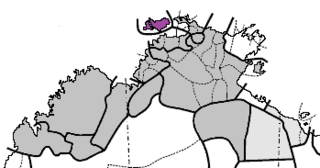
Back Idioma tiví Spanish Tivi keel (Austraalia) Estonian Tiwin kieli Finnish Tiwi (langue) French Lingua tiwi Galician Harshan TiWi Hausa Tiwi jezik Croatian Lingua tiwi Italian 티위어 Korean Tiwi (lingua) LFN
| Tiwi | |
|---|---|
| Native to | Australia |
| Region | Bathurst and Melville Islands, Northern Territory |
| Ethnicity | Tiwi people |
Native speakers | 2,103 (2021 census)[1] |
| Dialects |
|
| Language codes | |
| ISO 639-3 | tiw |
| Glottolog | tiwi1244 |
| AIATSIS[2] | N20 |
| ELP | Tiwi |
 Tiwi (purple), among other non-Pama-Nyungan languages (grey) | |
Tiwi /ˈtiːwi/[3] is an Australian Aboriginal language spoken by the Tiwi people on the Tiwi Islands, within sight of the coast of northern Australia. It is one of about 10% of Australian languages still being frequently learned by children.
Traditional Tiwi, spoken by people over the age of fifty by 2005, is a polysynthetic language. However, this grammatical complexity has been lost among younger generations. Tiwi has around one hundred nominals that can be incorporated into verbs, most of them quite different from the corresponding free forms.[4]
Tiwi has long been regarded as a language isolate due to its large scale of linguistic differences from other languages in the mainland Australia regions.[5] However, recent research using historical linguistic techniques suggests that the Tiwi language might be under the Gunwinyguan family (a language family that consists of languages primarily spoken in North Central Australia).[6]
- ^ "SBS Australian Census Explorer". Retrieved 9 January 2023.
- ^ N20 Tiwi at the Australian Indigenous Languages Database, Australian Institute of Aboriginal and Torres Strait Islander Studies
- ^ Laurie Bauer, 2007, The Linguistics Student’s Handbook, Edinburgh
- ^ Dixon, R.M.W. 1980. The languages of Australia. Cambridge University Press (Cambridge language surveys)
- ^ Liu, Lucy (4 October 2016). "Languages — School of Languages and Linguistics". Faculty of Arts. Retrieved 30 October 2020.
- ^ "Tiwi « Sorosoro". Retrieved 8 December 2020.